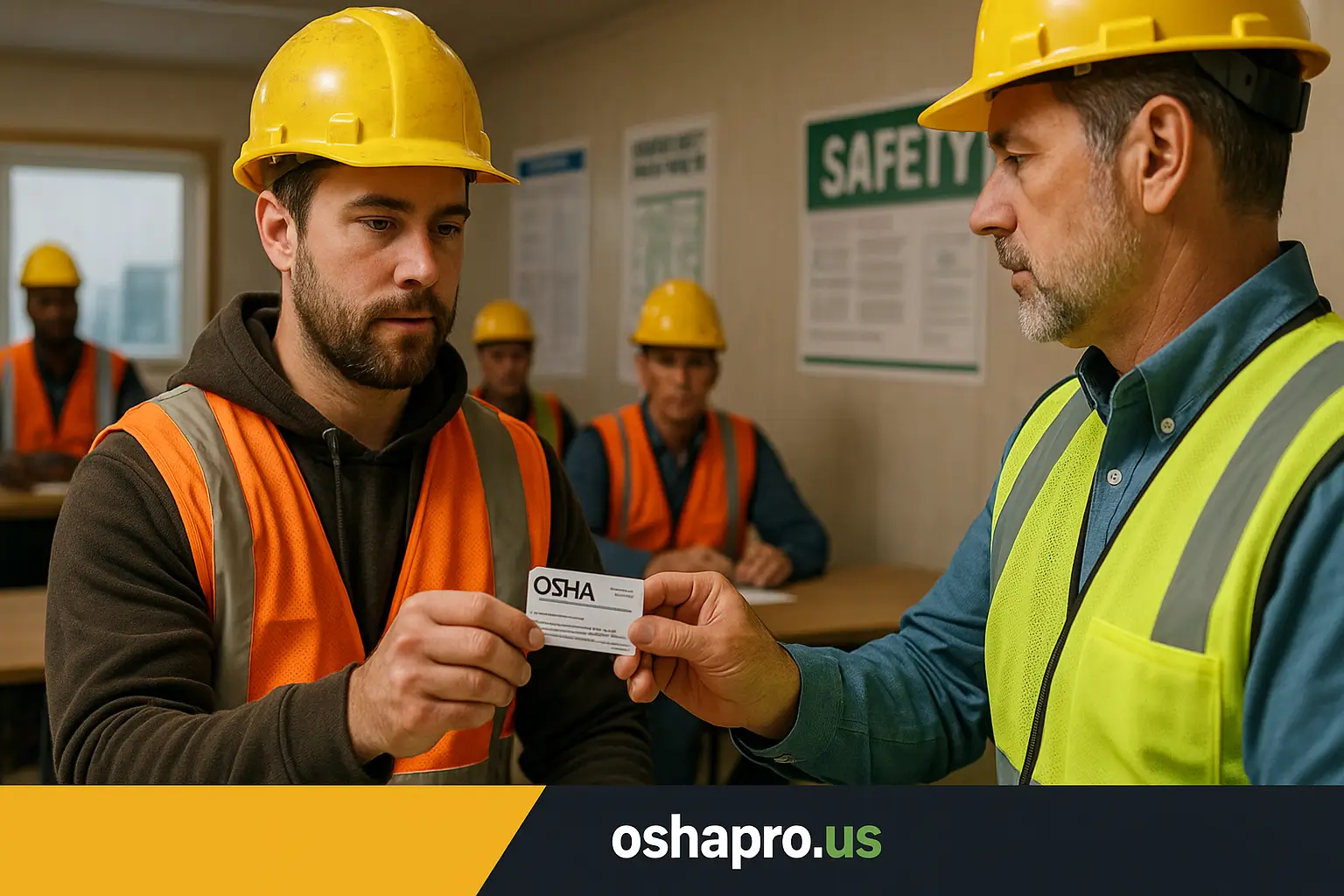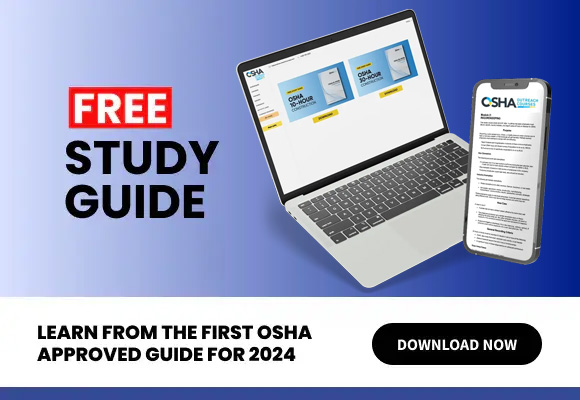The Occupational Safety and Health Administration (OSHA) is a federal agency dedicated to ensuring safe and healthy working conditions for employees across the United States.
Through its standards, inspections, and training programs, OSHA helps reduce workplace hazards and prevent injuries.
However, many people mistakenly talk about becoming “OSHA certified,” which isn’t technically accurate.
In reality, OSHA doesn’t certify individual workers; it authorizes specific training programs that issue completion cards and certificates.
This blog explains what OSHA training really means, how to get it, and why it’s essential for workplace safety. So, read on!
The Misconception: Why “OSHA Certified” Isn’t Technically Correct
OSHA does not directly certify individual workers or companies. Instead, the agency runs and oversees programs and authorizes third-party trainers to deliver specific outreach courses (commonly known as OSHA 10 and OSHA 30).
When people say they are “OSHA certified,” they usually mean they completed training through an OSHA-authorized provider and received a Certificate of Completion or an OSHA outreach card issued by the Department of Labor.
Those credentials show you finished the course, but they are not a formal certification issued by OSHA itself.
Calling oneself “OSHA certified” is a widespread shorthand, but it can be misleading. The accurate phrasing is “OSHA-trained” or “Completed OSHA-authorized training.”
This distinction matters in legal and professional contexts: employers, regulators, or clients may interpret “certified” to imply a different level of accreditation or third-party verification that OSHA does not provide to individuals.
Practically, the difference doesn’t reduce the value of the training. OSHA-authorized credentials are widely respected and often required by employers and local regulations. Still, it’s good practice to verify your provider is OSHA-authorized and to use correct terminology on resumes, job applications, and company policies.
Say “OSHA 30–hour trained” or “OSHA outreach card holder” rather than “OSHA certified” to be precise and avoid confusion.
What You Actually Receive: OSHA Training Cards and Certificates
When you complete an OSHA-authorized safety course, you don’t receive a certification; instead, you earn two key credentials: a Certificate of Completion from your training provider and an official OSHA card issued by the U.S. Department of Labor (DOL).
These documents confirm that an employee has completed federally approved safety training.
There are two main types of OSHA outreach cards: the OSHA 10-hour card and the OSHA 30-hour card.
The 10-hour card is designed for entry-level workers, covering fundamental safety topics like hazard recognition, fall protection, and workers’ rights. The 30-hour card, on the other hand, is intended for supervisors, site leads, and safety managers, offering more in-depth instruction on managing risks, conducting inspections, and ensuring compliance.
Both cards demonstrate your understanding of OSHA safety principles and your commitment to maintaining safe work practices.
However, it’s important to remember that these are proofs of training, not formal certifications.
They show that employees have completed OSHA-authorized education, but they are not equivalent to a professional license or certification granted by OSHA itself.
How to Complete OSHA 10-Hour and 30-Hour Courses
Here is the step-by-step guide to finishing OSHA outreach training and obtaining your OSHA DOL card.
Choose an OSHA-authorized trainer
Pick a provider listed as OSHA-authorized, either an online platform or a local classroom provider.
Confirm they offer the specific OSHA 10-hour or 30-hour outreach course and check reviews or employer acceptance if required for a jobsite.
Select the course that fits your role
Enroll in OSHA 10-Hour if you’re an entry-level worker needing basic hazard awareness.
Choose OSHA 30-Hour if you’re a supervisor, foreperson, or safety manager who requires more comprehensive training.
Register and verify identity
Most providers require you to create an account and verify your identity (photo ID or other documents) before training begins.
This ensures your completion record matches the DOL issuance.
Complete all required modules
Work through the mandatory course modules, topics include hazard recognition, fall protection, PPE, electrical safety, and worker rights.
OSHA 30 has more in-depth and additional topics than OSHA 10. Follow the provider’s lessons, videos, and reading materials.
Attend or participate as required
For in-person courses, attend scheduled sessions and meet any attendance requirements.
For online courses, follow the provider’s pacing rules; some allow self-paced completion, while others require a minimum time spent in each module.
Pass quizzes and final assessments
Complete any quizzes or final assessments that the training includes. Providers may require passing scores or full module completion for the course to count toward an official outreach card.
Receive confirmation and documentation
After satisfying all course requirements, the authorized trainer will issue a Certificate of Completion and submit your completion to the U.S. Department of Labor (DOL) outreach program.
The DOL card (OSHA outreach card) is then produced—some providers issue a temporary electronic card immediately, and a physical card by mail.
Keep records and share with employers
Save your certificate and card information. Employers or jobsite managers may request proof, and some jurisdictions accept electronic verification or require the physical card.
Why OSHA Training Still Matters Even If It’s Not “Certification”
Even though OSHA training isn’t a formal certification, it remains one of the most valuable credentials in workplace safety.
Completing an OSHA 10-hour or 30-hour course demonstrates that you understand how to identify and prevent hazards, follow safety protocols, and promote a culture of responsibility on the job.
This knowledge directly reduces the risk of workplace accidents, injuries, and costly violations, making OSHA training a practical necessity for workers and employers alike.
Many organizations and local jurisdictions across the U.S. now require OSHA training as part of employment eligibility.
For example, states like Nevada and cities like New York City mandate OSHA 10 or 30-hour courses for construction and related industries.
Employers also favor OSHA-trained workers because they’re better prepared to handle real-world safety challenges and comply with federal and local safety standards.
In short, even if OSHA doesn’t “certify” individuals, its authorized training equips workers with the essential safety awareness and professional credibility needed to succeed in high-risk industries, making it a cornerstone of workplace preparedness and compliance.
Wrap Up
While OSHA doesn’t technically “certify” individuals, its authorized training programs play a vital role in building safer, more informed workplaces.
Completing an OSHA 10-hour or 30-hour course shows a clear commitment to safety, compliance, and professional growth, qualities every employer values.
These credentials prove that you’ve been trained to recognize and prevent hazards, protect yourself and others, and meet federal and local safety requirements.
In short, you can’t get “OSHA certified,” but you can become OSHA trained, and that’s what truly matters when it comes to creating a safe, compliant, and productive work environment.

